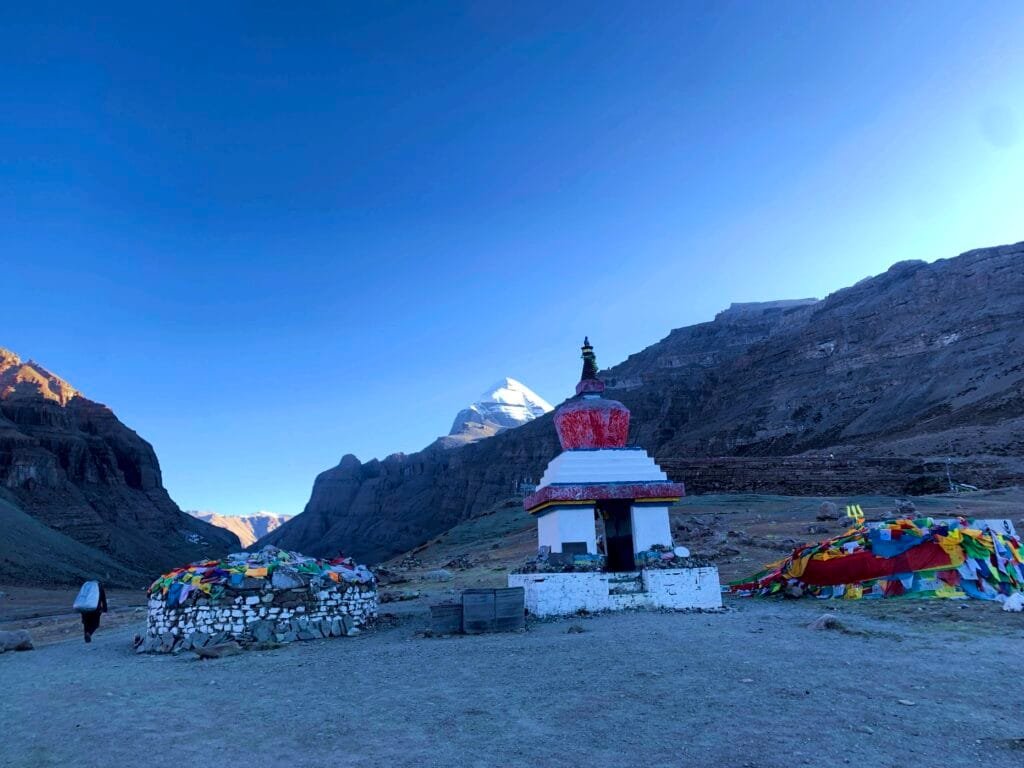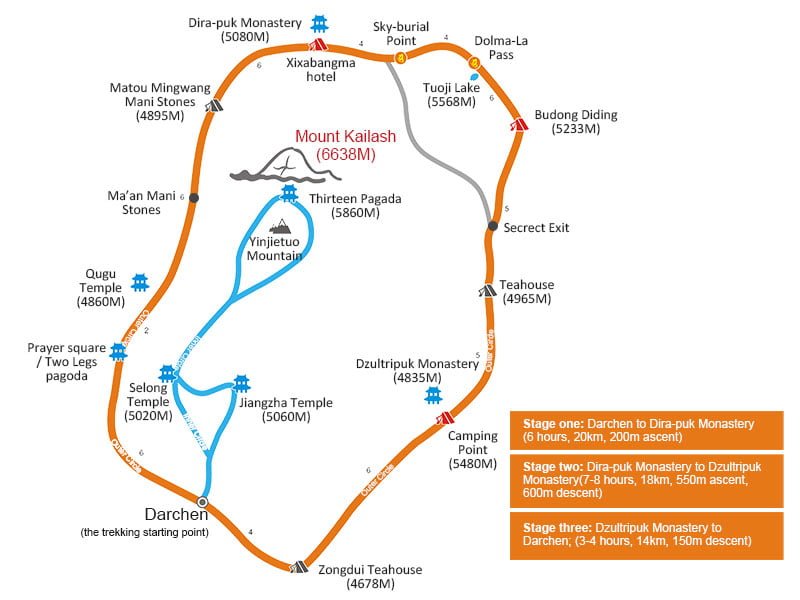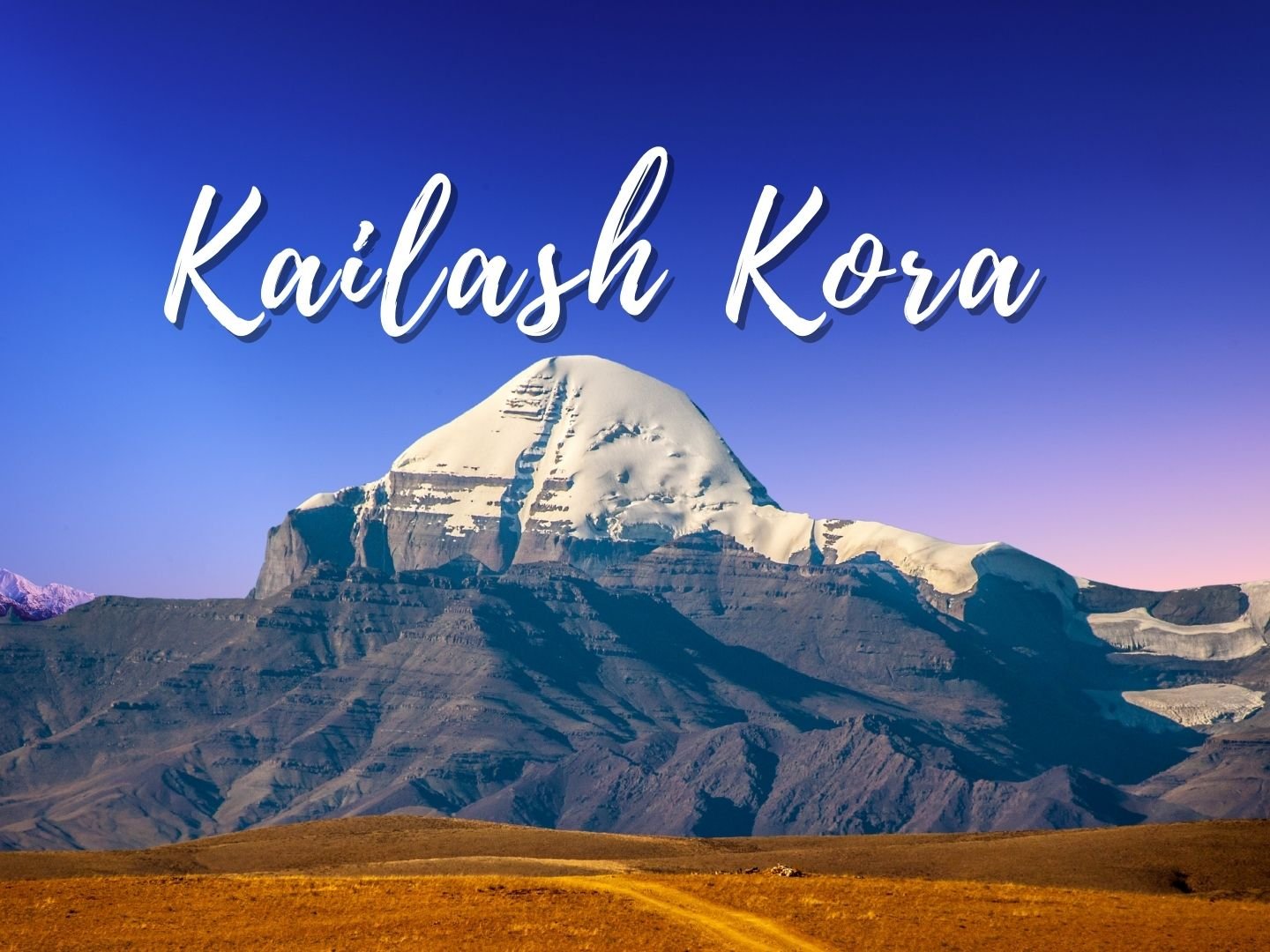Mount Kailash, a Sacred Mountain for Believers from Different religions
Mount Kailash, also known as Gang Rinpoche, stands majestically in the Gangdise Mountain range of Western Tibet. At an altitude of 6,638 meters, this sacred mountain is not only a natural wonder but also a spiritual epicentre for multiple religions. Surrounded by over 250 glaciers, Mount Kailash is the pivotal source of some of Asia’s major rivers – the Indus, Ganges, and Yarlung Tsangpo. This geographical prominence makes it a critical water source for the Indian subcontinent.
The mountain’s unique structure, with four distinct faces pointing towards the cardinal directions, adds to its mystical appeal. The southern face, marked by a symbolic cleft, is especially revered in Buddhist traditions. Mount Kailash holds immense religious significance across various beliefs. For Hindus, it is the divine abode of Lord Shiva, while Buddhists view it as the home of deity Demchok. Jains revere it as a site of emancipation, and it’s a sacred place for the Bön religion of Tibet.
Unconquered Summit: A Symbol of Divine and Natural Majesty
The peak of Mount Kailash, at 6,714 meters, remains untouched by climbers. Respecting its sacred status, many have halted their expeditions, keeping the mountain’s sanctity intact. Mount Kailash is a major pilgrimage site, attracting devotees from around the world. According to Buddhist beliefs, performing a kora (circumambulation) around the mountain can cleanse sins. Completing 108 koras is believed to lead to enlightenment. Legends also intertwine with the mountain, considering it the world’s navel and potentially the mythical Mount Meru.
Mount Kailash’s spiritual resonance, combined with its environmental significance, continues to inspire and attract pilgrims, adventurers, and those seeking spiritual solace. Its unspoiled beauty and sacredness make it one of the most revered peaks in the world.
The Global Significance of Mount Kailash
Mount Kailash, recognized globally as a sacred mountain, holds a central place in several major religious traditions. This revered peak is not only an important symbol in Tibetan Buddhism. The Bon religion, and ancient Hinduism but also the birthplace of the Bon religion. Surrounding Kailash are diverse religious groups, each with their unique perceptions, practices, and rituals. Despite these differences, they share a common, primal ritual – walking. This act serves as a physical expression of faith and a journey towards spiritual enlightenment.
The act of walking around Mount Kailash transcends religious boundaries, symbolizing a unified expression of devotion. This simple yet profound ritual is a testament to the mountain’s universal appeal as a spiritual beacon. Each year, from April to October, Mount Kailash becomes a hub for pilgrims. This period is considered ideal for undertaking the journey, offering favourable conditions for those seeking to engage in this sacred ritual.
Exploring Mount Kailash: A Spiritual Journey

Overview of Mount Kailash’s Kora (Circumambulation) Paths
Mount Kailash, a sacred peak in Tibet, offers two distinct paths for pilgrims and tourists: the outer kora and the inner kora. The outer kora is accessible to tourists, while the inner kora, with its higher risks, is reserved for those with special religious qualifications.
Outer Kora: The Pilgrim’s Path
The outer kora of Mount Kailash spans about 54 kilometres, providing a blend of spiritual journey and physical challenge. This route passes through significant landmarks like Zhire Temple, Dolma La Pass, and Zunzhu Temple. Depending on fitness levels and experience, the journey can take one to three days.
- One-Day Trip: A rigorous option for seasoned climbers, covering the entire route in 15-18 hours, including key milestones like Zhire Temple and Dolma La Pass.
- Two-Day Trip: Suitable for those with good physical condition and no altitude sickness. The journey is split into two stages. First from Tarchen to Zhire Temple on the first day and returning via Zunzhu Temple on the second day.
- Three-Day Trip: Ideal for families or those preferring a slower pace. This journey breaks down the route into three manageable stages over three days.
Spiritual Essence of Inner Kora: The Sacred Route
- Buddhist Legend: The terrain itself, comprising mountains, rivers, vegetation, and trees, is believed to embody Buddha nature. Mount Gaduo, a central feature of this route, represents the head of the sixteen saints.
- Symbolic Landscape: The surrounding landscape is a rich tapestry symbolizing various Buddhist figures, including Arhats, Bodhisattvas, Sravakas, and those who have attained Solitary Enlightenment.
Key Religious Landmarks
- Gyangda Temple: An important spiritual site on the inner kora, offering a deep connection to the region’s religious history.
- Selong Temple: Another significant temple that marks this sacred path.
- Thirteen Golden Pagodas: These symbolize the pinnacle of religious reverence in the area, further emphasizing the route’s sanctity.
Qualifications for the Inner Kora
- The threshold for Participation: The inner kora demands high religious qualifications, making it a path less travelled. Pilgrims must complete 13 rounds of the outer kora to be eligible for the inner kora.
- A Quieter Journey: In contrast to the busy outer kora, the inner kora offers a more tranquil and introspective experience, with fewer pilgrims undertaking this sacred journey.
The inner kora of Mount Kailash, with its profound spiritual significance and serene ambience, presents a unique opportunity for those seeking a deeper connection with Buddhist traditions and a more intimate encounter with the sacred landscape of Kailash.
Supply Points and Transportation
- Climbing Tickets: Required for the journey, checked between the prayer flag square and supply point ①.
- Transport Options: Various sections offer transportation services, including buses and rescue vehicles, with fares ranging from 50 to 500 yuan.
- Horseback Riding: Available on specific sections, with fares set at 200 yuan per section.
Season for Pilgrimage
The ideal time for undertaking this spiritual journey is from April to October, offering the best conditions for both outer and inner kora paths.
A Journey of Faith and Endurance
Mount Kailash’s kora paths offer a unique blend of physical challenge and spiritual enrichment. Whether opting for the accessible outer kora or the more secluded inner path, pilgrims and tourists alike can experience a journey that transcends mere tourism, delving deep into the heart of Tibetan spiritual and cultural traditions.
Exploring the Sacred Path of Mount Kailash: A Journey Through Temples and Legends

The Three Temples on the Outer Kora of Mount Kailash
- Chugu Temple
- Historical Significance: Built in the 13th century by Guotsangba, founder of the Drukpa Kagyu Sect of Tibetan Buddhism.
- Location: Perched high on the canyon’s western rock wall, offering a stunning view of Kailash’s west wall.
- Unique Features: Below the temple lies the hidden Elephant Cave, where Padmasambhava practised Buddhism.
- Main Deity: Chugu Buddha, symbolizing the ultimate fruition of Dharmakaya.
- Amenities: Temporary tents for food and water during peak pilgrimage season.
- Zheripu Temple
- Prime Location: On the north side of Lachu River, facing Kailash’s north wall.
- Historical Connection: Guotsangba’s practice site, features his cave and a head imprint on the rock wall above.
- Scenic Views: Offers breathtaking views of Kailash under different lights throughout the day.
- Accommodations: Basic lodging and nearby Shishapangma Hotel.
- Zutrupu Temple
- Strategic Position: Directly east of Mount Kailash, facing east and west.
- Historical Background: Named after the “Magic Cave” behind the main sutra hall, associated with Milarepa’s magic.
- Lodging: Simple lodging is available, especially during peak season.
360° Views of Kailash
- Best Viewing Spot: Zheripu Temple, for its direct view of Kailash’s north wall and the pyramid-shaped ice wall.
- Best Photography Spot: Capture Mount Kailash’s sunrise from the route over Zhuomala Pass.
A Lake of Legends: Tojicuo (Mercy Lake)
- Scenic Beauty: Jade-green lake visible from Zhuomala Pass, surrounded by legends and considered a sacred bath in Hindu and Buddhist beliefs.
The Glacial Rivers of Kailash
- Natural Wonder: Eight glaciers form an 8-petal lotus around Kailash, giving birth to rivers named after celestial beings.
- Water Sources: The rivers, named after horses, lions, elephants, and peacocks, are sources of major rivers like the Brahmaputra and Ganges.
Miracles and Legends Along the Path
- Buddha’s Footprints: Three immovable nails representing Buddha’s stabilizing footprints.
- Milarepa and Naruo Benqiong’s Competition: Legends of their magical powers and the traces they left behind.
- King Gesar’s Saddle Stone: A saddle-shaped stone linked to folklore about King Gesar’s mount.
- Dolma Stone: At Zhuomala Pass, a stone with Tara’s statue, associated with a legend of GuoTsangba’s journey and the wolf incarnations of Tara.
This journey around Mount Kailash, rich in spiritual heritage, scenic beauty, and mystical legends, offers a profound experience for every pilgrim and traveller.
Mount Kailash Pilgrimage: A Journey of Spiritual Significance
Mount Kailash, a sacred mountain in Tibet, is a significant pilgrimage site with deep spiritual implications for those who visit to perform the ritual circumambulation, known as kora.
Spiritual Rewards of the Kailash Kora
- Three Circuits: Belief holds that completing three rounds around the mountain cleanses a lifetime of sins.
- Twenty-One Circuits: Completing twenty-one koras will prevent suffering in hell for five hundred reincarnations.
- One Hundred and Eight Circuits: Achieving this formidable number of koras is thought to grant Buddhahood in one’s current life.
- Special Year of the Horse: Performing one circuit during the year of the horse amplifies the merit twelvefold, equivalent to thirteen regular circuits.
The Unbroken Stream of Pilgrims For centuries, a continuous flow of pilgrims has made the journey to Mount Kailash, creating a moving spectacle along the paths leading to this revered peak.
Outer and Inner Kora of Mount Kailash
- Outer Kora: This is the more common route taken by pilgrims.
- Inner Kora: Known as the Dharma Protector Mountain of Kailash, named Yinjieduo, represents a more sacred and challenging path. Yin Jeduo symbolizes the head of the sixteen Arhats, with the surrounding landscape representing Arhats, Bodhisattvas, Sravakas, and those in Solitary Enlightenment.
- Qualifications for the Inner Kora: To embark on the inner kora, one must first complete 13 circuits of the outer kora. This higher threshold reflects the inner kora’s deep religious significance.
Starting Point and Safety on the Inner Kora
- Starting Point: The inner kora begins at Serong Temple, situated at an altitude of 5,020 meters, a small yet spiritually significant site.
- Safety Precautions: Given the route’s challenging nature, pilgrims are reminded to prioritize safety.
Experiencing the Inner Kora The sacredness of the inner kora at Mount Kailash is something profound and personal, often beyond capture in photos or videos. It offers an experience that needs to be lived to be truly understood, providing a unique and deeply spiritual journey for those who undertake it.
Saga Dawa Festival: A Celebration of Faith at Mount Kailash
For the Tibetan community, the Saga Dawa Festival is the most significant event at Mount Kailash. People celebrate this revered festival on the 15th day of the fourth month in the Tibetan lunar calendar, typically corresponding to April or May in the Gregorian calendar.
Festival Activities and Rituals
- Gathering of Believers: Devotees from various Tibetan regions converge at Sexiong, near the base of Mount Kailash.
- Prayer Flag Pillar Ceremony: A central feature of the festival is the erection of a giant prayer flag pillar, a symbol of spiritual aspirations and blessings.
- Monastic Chants and Devotee Rituals: Eminent monks sit near the prayer flag pillars, reciting sutras, while believers engage in worship, meditation, prostration, and ritual circumambulations.
- Culmination at Noon: The prayer flag pillar is gradually raised and stands upright by noon, marking the peak of the festival. This moment is greeted with cheers, the release of prayer papers, and the scattering of tsampa (barley flour) as symbols of joy and sanctification.
- Commencement of Pilgrimage: With the prayer flags hoisted, the annual pilgrimage activities around Mount Kailash officially begin.
Experiencing Mount Kailash during Saga Dawa
- Journey to the Mountain: Pilgrims embark on the sacred kora, experiencing the majestic landscapes of Mount Kailash up close.
- Changing Perspectives: As believers traverse around the mountain, they encounter varying views of Kailash, each offering a unique perspective yet inspiring the same profound reverence.
A Unifying Spiritual Experience
The Saga Dawa Festival at Mount Kailash is more than a religious event; it’s a unifying spiritual experience that brings together the Tibetan community in a celebration of faith, devotion, and cultural heritage. It’s an opportune time for both devout pilgrims and curious visitors to witness the deep spiritual connection between the Tibetan people and their sacred mountain.
Mount Kailash: The Sacred Summit in the Heart of Tibet
Nestled within the vast plateau of Ngari in western Tibet, the Gangdese Mountains form a majestic natural barrier between the Kunlun Mountains in the north and the Himalayas in the south. Among these towering peaks lies Mount Kailash, a sacred mountain revered by multiple religious traditions and standing as a prominent feature at 6,656 meters above sea level.
Kailash: A Multifaceted Spiritual Icon
- Sacred Status: Recognized worldwide as a sacred peak, Mount Kailash holds a central place in several religions, including the Yongzhong Bon religion of Tibet, Hinduism, Tibetan Buddhism, and ancient Jainism.
- Unique Appearance: Although not the highest in the region, its snow-clad peak radiates a unique brilliance in the sunlight, capturing the gaze of onlookers.
- Buddhist Connection: In Buddhism, Mount Kailash is often equated with Mount Sumeru, a mythical mountain at the centre of the universe.
Religious Significance Across Cultures
- Hinduism: Known as Kailash in Sanskrit, it is revered as the abode of Lord Shiva and considered the world’s centre. Mention in Various Hindu epics like Ramayana and Mahabharata.
- Jainism: Referred to as Ashtavada, Kailash is believed to be the site where the religion’s ancestor, Rishaba, attained liberation.
- Tibetan Buddhism: Seen as the residence of Demchok (Chakrasamvara), embodying boundless joy, attracting pilgrims throughout the year.
- Yongdrung Bon Religion: Originating from Kailash, this mountain is deemed the landing place of the religion’s founder, Tonpa Shenrab.
Historical and Cultural Perspectives
- Mount Sumeru: As per the “Little Dictionary of Buddhism,” Mount Sumeru is conceptualized as the small world’s centre in Buddhist cosmology.
- Pre-Buddhist Era: During the Shangshung Yongdrong Bon Religion period, Kailash was known as the “Ten Thousand Character Mountain,” believed to be inhabited by 360 gods of the Bon Religion.
Mount Kailash, with its rich tapestry of spiritual and cultural significance, stands not just as a geological wonder but as a beacon of faith and mysticism, drawing seekers and believers from various traditions to its sacred slopes.
The Legendary Duel of Wisdom atop Mount Kailash
In the year 1093 AD, Milarepa, the esteemed master of the Kagyu sect of Tibetan Buddhism, arrived at Mount Kailash, a revered peak in the heart of Tibet, stirring its serene silence. His intent was to meditate and absorb the mountain’s sacred energy, but his plans were soon to face an unexpected challenge.
Naruo Benqiong, a master of the ancient Bon religion, guarded Kailash with a fervent belief that it belonged solely to his faith. The sight of Milarepa, a Buddhist, seeking spiritual solace on what he considered Bon’s holy ground, sparked a fiery dispute. Naruo Benqiong, with a firm voice, declared that Buddhists had no place on this sacred mountain, setting the stage for an unusual contest of wit and mystical power.
The Confrontation for Sacred Ground
A challenge was proposed by Naruo Benqiong: on the fifteenth day of the second Tibetan month, whoever first reached the peak of Kailash would be declared the rightful spiritual guardian of the mountain. The day arrived, and as dawn’s first light crept across the sky, Naruo Benqiong, filled with determination, mounted his Dharma drum and soared towards the peak.
Meanwhile, Milarepa, seemingly unperturbed, remained in a state of calm repose, his eyes half-closed, his posture relaxed. His disciples, witnessing Naruo Benqiong’s swift ascent, grew anxious, fearing their master’s apparent inaction.
But as the sun’s rays kissed the summit, Milarepa revealed the depth of his wisdom and power. In a moment of divine inspiration, he transformed his simple cloth into wings of light and glided gracefully to the top, reaching it simultaneously with the first beam of sunlight.
Milarepa’s Miraculous Triumph
Naruo Benqiong, exerted and drenched in sweat, arrived at the peak, confident of his victory. Yet, to his astonishment, he found Milarepa already seated there in serene meditation. Overwhelmed by a mix of surprise and respect, Naruo Benqiong conceded defeat and slid down the mountain with his drum, leaving behind a deep groove on the southern slope – a mark that would tell their tale for ages to come.
Acknowledging Naruo Benqiong’s devotion, Milarepa granted him a place on Daleze Mountain, to the east of Kailash, where he could continue his spiritual practices in sight of the sacred peak.
This legendary duel marked a turning point in the spiritual landscape of Mount Kailash. The Bon religion’s singular influence waned, paving the way for the Kagyu sect of Tibetan Buddhism to establish monasteries and spread their teachings. Thus, the saga of Milarepa and Naruo Benqiong became a tale of wisdom, respect, and the mystical union of faiths at Mount Kailash.
Essential Equipment Checklist for Trekking in Kailash
When preparing for a trek in the Kailash region, it’s crucial to pack the right equipment and supplies to ensure a safe and comfortable journey. Here’s a comprehensive list of what you should consider bringing:
Clothing:
- Warm Layers: The temperature can be quite low, especially in the mornings and evenings. Pack down jackets, fleece jackets, and thermal layers.
- Pants: Opt for loose-fitting, comfortable pants. Quick-drying or disposable underwear is recommended.
- Underwear: Choose pure cotton for comfort and breathability.
Food Supplies:
- High-Energy Snacks: Include items like chocolate and compressed biscuits for quick energy boosts.
- Protein-Rich Foods: Pack portable options like ham sausages.
- Instant Meals: Instant noodles can be a handy meal option, with hot water available at temples along the route.
- Note on Availability: While some dry food is sold at temples en route, it’s often expensive, so bring enough supplies.
Medications:
- Basic Medicines: Include cold medicine, antidiarrheal, gastrointestinal medicine, and antipyretics.
- Specific Needs: Don’t forget any personal medication, like anti-hypertension drugs.
- Topical Treatments: Pack Fengyoujing for mosquito bites and a bruise ointment.
- Quantity: A small amount of each type is sufficient.
Sun Protection:
- Headwear: Bring a hat to shield your face from the sun.
- Eye Protection: Sunglasses are essential for UV protection.
- Skin Care: Sunscreen is a must to prevent sunburn.
- Accessories: Gloves and a wind towel can provide extra protection.
Hiking Gear:
- Footwear: Sturdy hiking shoes are crucial for rough terrains.
- Support Equipment: Trekking poles can significantly reduce the strain on your legs.
- Sleeping Arrangements: Pack a sleeping bag, and consider bringing a tent if you prefer not to rely on local accommodations.
Essential Documents:
- Identification: Carry your ID card at all times.
- Border Defense Permit: This is mandatory for entering certain areas like Taqin Village.
Proper preparation with these items will help ensure a safe, enjoyable, and memorable trekking experience in the majestic landscapes of Kailash.
Essential Precautions for Mountain Trekking
Embarking on a mountain trek, especially in high-altitude and challenging environments like those found in Tibet, requires careful preparation and adherence to safety guidelines. Here are some crucial precautions to keep in mind:
- Comprehensive Preparation:
- Physical Readiness: The trek will be physically demanding. Ensure you are in good physical condition before attempting the climb.
- Altitude Awareness: High altitudes pose the risk of altitude sickness. Acclimatize properly and be aware of the symptoms.
- Cold Climate: Temperatures can be extremely low, so it’s essential to dress warmly in layers to protect against the cold.
- Knee Protection:
- Post-Pass Descent: A sudden descent after reaching a pass can be tough on your knees.
- Use of Kneepads: Wearing kneepads is strongly advised to provide necessary support and protection for your knees.
- Eye Protection:
- Snow Glare: The reflection from the snow can be harmful to your eyes.
- Sunglasses Requirement: Always wear UV-protective sunglasses to prevent eye irritation or temporary snow blindness.
- Communication Plan:
- No Mobile Signal: Be aware that there will be no mobile phone coverage during the trek.
- Inform Loved Ones: Notify family and friends of your plans and the lack of connectivity to alleviate any potential worry.
- Packing Tips:
- Light Packing: Carry only the essentials to ease your journey.
- Avoid Heavy Equipment: Leave behind bulky items such as SLR cameras, which can add unnecessary weight.
Taking these precautions seriously will not only enhance your safety and comfort during the trek but also ensure a more enjoyable and fulfilling mountain experience.



